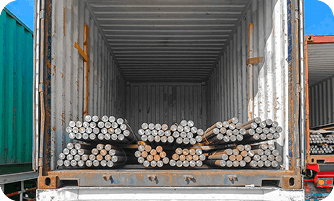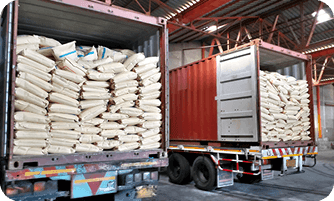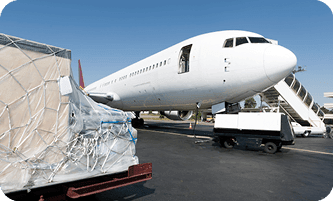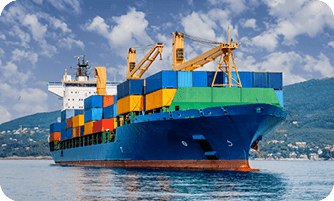Tips on Getting the Best Freight Shipping Rates
Managing freight shipping costs is a crucial aspect of supply chain management. With the ever-changing landscape of the shipping industry, it's essential for businesses (like you!) to stay informed and adopt effective strategies to optimize their freight shipping expenses. That comes in many different shapes and sizes, including managing additional fees, surcharges and other expenses.
In this comprehensive blog, we will dive into the intricacies of freight shipping rates, exploring the key factors that impact costs and provide practical tips to help you achieve significant freight savings. From understanding your freight shipping frequency and shipment details to comparing different freight shipping services and optimizing packaging, we've got you covered. Get ready to discover how to get the best freight rates and enhance your overall supply chain efficiency!
Understand Your Freight Shipping Needs
Before diving into comparing freight shipping services and negotiating rates, it's essential to gain a clear understanding of your freight shipping needs. This involves several key considerations that will guide your decision-making process and ensure you find the best freight shipping rates for your business.
By thoroughly understanding your freight shipping service needs, including shipping frequency, shipping speed requirements, and freight classifications, you can make informed decisions about freight shipping and optimize your shipping strategy. This knowledge will empower you to negotiate the best freight shipping rates for your business and achieve cost savings without compromising on service quality. Score!
Evaluate your freight shipping volume
Start by evaluating your shipping frequency, which refers to the frequency and quantity of your shipments. Determine how often you need to ship goods and estimate the average number of shipments per week or month. This information will help you assess whether you qualify for volume discounts or if you should consider alternative transportation modes such as intermodal or multimodal shipping.
Determine your freight shipping speed requirements
Consider the urgency of your freight shipments and the expectations of your customers. Do you need expedited shipping for time-sensitive deliveries, or can you opt for more cost-effective standard shipping? Understanding your service requirements will enable you to choose the appropriate shipping method and avoid unnecessary costs.
Assess your freight size and weight
When assessing your freight size and weight, it's crucial to use accurate measurements to avoid unexpected shipping expenses. Proper packaging can significantly reduce dimensional weight charges, ensuring you only pay for the space your items actually use. Additionally, choosing appropriate packaging materials can prevent adding unnecessary weight, helping to keep shipping costs down while ensuring the safety of your goods during transit. Remember, accurate assessment and strategic packaging are key to efficient and cost-effective shipping.
Understand freight classifications
Finally, familiarize yourself with freight classifications, which categorize freight shipments based on their characteristics and value. The National Motor Freight Classification (NMFC) system is widely used in the freight industry, and it assigns a unique freight class to each type of commodity. Knowing the freight class of your shipments will help you determine the applicable freight rates and avoid any potential reclassification fees.
Consider the Different Freight Shipping Options
There are many freight shipping options! And choosing the right one is crucial for the efficiency and cost-effectiveness of transporting goods. Check out this shipping option comparison which explores the advantages and limitations of the most common modes, considering factors like distance, speed, cost savings, capacity and more to help you determine the best freight shipping method for your specific needs.

Ground
Less-Than-Truckload (LTL)
Combines freight from multiple businesses into one full truckload. Ideal if your shipment is too large for small package shipping, but you don’t have enough freight to fill an entire trailer.

Ground
Full Truckload (FTL)
Used to transport cargo that weighs more than 20,000 pounds or freight that can fill an entire trailer.

Air
Allows you to ship quickly and reliably to virtually anywhere — domestic or internationally — by plane.

Ocean
Works by packing goods into ocean shipping containers that move from port to port. Can be shipped as a less-than-container load (LCL), full container load (FCL) or break-bulk.
Choose between LTL and FTL freight services
Businesses have a range of shipping options to choose from, each with its own impact on freight shipping rates. Less-than-truckload (LTL) freight shipments are ideal for smaller freight quantities that don't fill an entire truck, while full truckload (FTL) shipments are suitable for larger and heavier-weight loads. Comparing LTL and FTL rates from multiple carriers is crucial to securing the best deals. Additionally, negotiating rates with carriers can yield significant savings, especially for high-volume shippers.
Explore specialty freight transportation modes
When dealing with specialty freight, such as hazardous materials or perishable items, it's crucial to understand the associated surcharges and additional fees. These can vary based on the type of freight, its value, and the level of risk involved. To avoid unexpected expenses, businesses should thoroughly research and understand all applicable surcharges and additional fees before finalizing their specialty shipping arrangements.
Optimize Your Shipping Process
Beyond understanding rates, optimizing your shipping process is vital for cost savings and efficient supply chain management. Additionally, streamlining operations and leveraging technology can significantly reduce shipping expenses. By evaluating your current shipping practices and identifying areas for improvement, you can increase efficiency and save money!
Shipping technology and software
Consider implementing shipping software — like a transportation management system (TMS) — and automation tools to streamline shipping processes, track shipments, get quotes, add freight insurance, optimize routes and handle invoicing. This not only reduces manual labor and human error but also provides real-time visibility into your supply chain, enabling proactive decision-making.
Proper freight packaging
Efficient packaging can yield substantial cost savings. That includes using the right-sized packaging materials to minimize and avoid surcharges. Additionally, choose packaging materials that are lightweight and durable enough to protect your goods without adding unnecessary weight. By optimizing your packaging, you can significantly reduce costs and minimize the risk of damage during transit.
Leverage a 3PL for freight shipping savings
Third-party logistics (3PL) service providers can play a vital role in managing the shipping process and finding the most cost-effective rates. They have extensive networks and expertise in the freight industry, often securing better rates than businesses can negotiate on their own. By carefully evaluating the factors above and leveraging a 3PL, businesses can make informed decisions about their shipping options and achieve optimal cost savings and efficient supply chain management.
Watch Out for Additional Fees
Freight shipping can be a complex process, and there are a number of factors that can affect the total cost of shipping your goods. In addition to the base rate, there are potential additional fees that you should be aware of. These charges can include:
- Surcharges: These are additional fees that can be added to your freight bill for a variety of reasons, such as fuel costs, peak season surcharges, or hazardous materials fees. Be sure to ask your freight carrier about any potential surcharges that may apply to your shipment.
- Accessorial fees: Additional fees (sometimes called “hidden fees”) may also be charged for services such as liftgate service, inside delivery, or residential delivery. These fees can vary depending on the carrier and the specific service required.
- Reclassification fees: If your freight is misclassified, you may be charged a reclassification fee. This fee can be significant, so it's important to make sure that your freight is properly classified before shipping.
- Late payment fees: Many freight carriers charge late payment fees if your invoice is not paid within the specified timeframe. These fees can add up quickly, so it's important to pay your freight invoices on time.
- Oversized packages: Oversized freight may be subject to additional charges. The definition of what constitutes an oversized package can vary from carrier to carrier, so be sure to check before shipping any large or bulky items.
- Extra services: Extra services, such as expedited and other kinds of specialty shipping, can also add to the cost of your shipment. Check with your carrier and be sure to only purchase the services that you need.
By being aware of these potential additional charges, you can avoid unexpected shipping expenses and keep your costs under control. That’s a good thing!
Freight Shipment Tracking and Monitoring
In the freight shipping industry, ensuring accurate billing and shipment monitoring is crucial for businesses looking to manage their expenses effectively. By harnessing the power of tracking and monitoring tools — like a transportation management system (TMS) — businesses gain proactive visibility into their shipments, allowing them to promptly address any potential issues that may arise during transit.
Freight shipment monitoring
Leveraging monitoring technology empowers businesses to make informed decisions, optimize their shipping processes, and ultimately achieve significant freight cost savings and efficient supply chain management. Additionally, by meticulously monitoring their freight shipment details, businesses can identify patterns and trends that enable continuous improvement, leading to streamlined operations and overall enhanced performance.
Freight shipping tracking capabilities
For businesses that frequently engage in intermodal, or multimodal transportation modes, investing in advanced tracking software and partnering with reliable 3PL services can provide access to real-time updates and sophisticated analytics. These tools offer businesses unparalleled insights into their shipping patterns, allowing them to optimize their supply chain and make data-driven decisions that result in significant cost savings and increased efficiency.
Partnering for Success With a Freight Shipping 3PL
In the ever-evolving landscape of the freight industry, businesses seeking the best results can often find themselves overwhelmed by the complexities of shipping. Fortunately, partnering with a seasoned expert like Unishippers can transform this challenge into an opportunity for significant cost savings and streamlined supply chain management. When you work with us, you can:
- Access freight solutions and a carrier network second to none. Unishippers offers a comprehensive range of freight solutions tailored to meet the unique needs of small and medium-sized businesses. By leveraging our , we provide access to a wealth of resources to optimize your shipping for cost savings.
- Work with a team of freight shipping experts. Our team of experienced 3PL logistics professionals is dedicated to delivering personalized support, acting as an extension of your business to ensure seamless freight shipments. We meticulously analyze your freight service requirements to develop a customized shipping strategy that aligns with your business goals. Whether you require expedited shipping for time-sensitive deliveries or cost-effective options, we have the expertise to create a tailored solution that meets your specific needs.
- Leverage innovative shipping technology. Unishippers offers advanced shipping tools and technology to simplify and enhance your shipping process. Our user-friendly myUnishippers shipping software and automation tools provide real-time tracking, monitoring, and comprehensive reporting capabilities. This empowers you with greater visibility and control over your freight shipments, enabling informed decisions and efficient supply chain management.
By partnering with Unishippers, you gain access to a wealth of expertise, resources, and technology that can transform your shipping process and drive significant cost savings! If you are ready to talk to an expert, reach out for a free consultation today!
FAQs About Freight Shipping Rates
Less-than-truckload (LTL) shipping is generally cheaper for smaller shipments that don't require a full truck, as you only pay for the space your goods occupy. FTL (Full Truckload) is more cost-effective for large shipments that can fill an entire truck, as it eliminates the need to share space and often travels directly to the destination without stops.
Freight rates can fluctuate due to various factors such as fuel prices, demand, and economic conditions. It's important to stay updated with industry trends or consult with logistics experts to get the latest information on rate changes.
To negotiate better freight rates, gather multiple quotes to understand the market average. Use your shipping volume as leverage and discuss long-term partnership possibilities with carriers. Being flexible with your shipping dates and requirements can also help in securing lower rates.
The cost of shipping is determined by factors including the mode of transport, weight and dimensions of the shipment, distance to the destination, and any additional services like insurance or special handling. A 3PL can help you shop around for the best prices.
Volume shipping discounts are offered by carriers when you ship large quantities or meet certain volume thresholds. These discounts are designed to encourage bulk shipments by reducing the cost per unit, making it more economical for frequent shippers or those sending large amounts of goods.
Everything You Need To Know About Freight Shipping
Want to upgrade your freight shipping game? Get tips and information on freight classification, shipping rates, technology, specialty shipping and more in our Ultimate Guide To Freight Shipping.


